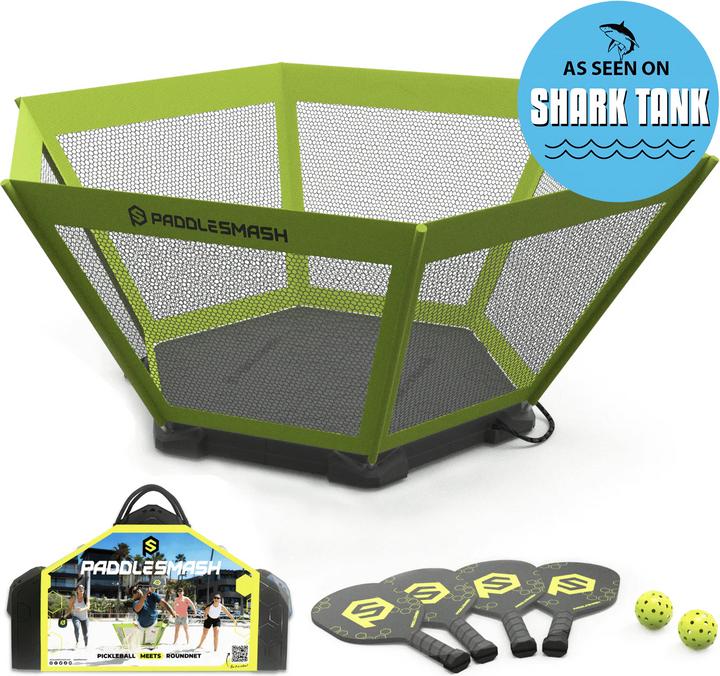
PaddleSmash, the summer game: love at second sight
If you like spikeball and racket games, you might enjoy PaddleSmash. After some initial difficulties, we really enjoyed our test round with four rackets and a stolen game idea.
Clack. Then. Smash! And then hit it again. Anyone who saw us outside the Galaxus offices at the start of our video shoot will have been slightly confused. Why are the four of them waving their rackets around that basket with the bright yellow net?
PaddleSmash, as Stefanie Lechthaler, Patrick Vogt, Luca Fontana and I play it, doesn’t look much fun in the first few minutes. Lots of mistakes, lots of swearing and a video producer who must’ve been mentally preparing himself for a lot of work. How do you edit this material into something usable for an article? But things got better.
The flow developed from minute to minute. Since the best way to make sense of the game is to watch the video, I recommend taking a look. For English captions, go to Settings > Subtitles/CC > Auto-translate. But since I know people prefer reading a report on Galaxus, I’ll of course explain the game in written format.
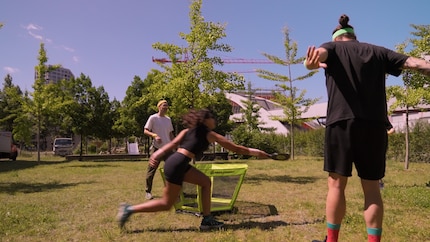
What is PaddleSmash?
I was drawn to PaddleSmash because it combines different things I like. For one thing, it involves a ball. It also includes rackets and a court that’s easy to set up. The game’s designed for four people (teams of two against two). And it’s competitive, so a bit of ambition won’t go amiss. Basically, it’s like spikeball, also known as roundnet. This net is stretched just above the ground. After a maximum of three ball contacts, the players have to hit the ball so the opposing team will struggle to return it.
PaddleSmash was invented by a father of seven from Utah whose children are particularly fond of two games: spikeball and pickleball. The latter is a type of small-court tennis that’s particularly popular in the US. Since there was no room for a pickleball court in front of the inventor’s house in Utah, he came up with something new: PaddleSmash. A court that’s surrounded by a net and has to be hit with a racket so the ball will bouncs out again. There’s no denying that the game idea is based on spikeball. On the contrary. It’s even advertised on the packaging. And in the successful search for investors on Shark Tank.
What’s in the set?
The basis of the whole thing is the case, which when unfolded forms the hexagonal court. It’s incredibly solid, and the game weighs around 9 kg in total. Inside the case are the net, six plastic rods, four wooden pickleball bats and two balls, described as a «mixture of indoor and outdoor» and designed to match the surface of the pitch.
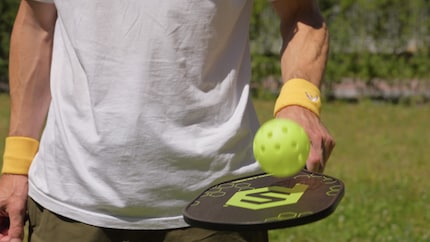
What’s it like to put together?
It only takes a few simple steps before you’re ready to get started. Turn the case upside down, insert the plastic rods into the loops provided on the net like a tent and push them into the holes on the edge of the court. You need five to ten metres of free space around the court in all directions. The better the players get, the more space they’ll use. It’s a bit more difficult to get the individual parts back into the case. So, it’s best to take a photo before unpacking for the first time or do as I do and get help on YouTube.
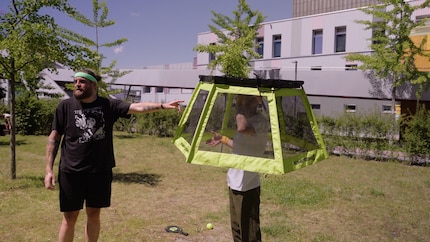
How do you play?
Preferably two against two. When it’s time to serve, you stand opposite the player on your team. The game starts by smashing the ball onto the ground and bouncing it over the net to the other player. After serving, a team has three ball contacts to smash the ball back onto the court and over the net – preferably in such a way that the opposing team can’t keep it in play. If the player fails to hit the ball back onto the court and over the net after a maximum of three contacts, the other team get a point. Here are some more rules in detail:
- Serving happens clockwise, and matches go to eleven. A two-point lead is mandatory, so if it’s close, the game is played to 12:10, 15:13 etc.
- Double touches are permitted. This means you can accept the ball and then play it a second time. But the third contact has to come from your teammate.
- Both players must have played the ball once before it’s smashed. This means you can’t counter a blow directly.
- The ball is allowed to touch the net. As long as it hits the ground and then makes it over the edge of the net, it’s still in the game.
- You can also touch the net with your racket or body as long as you don’t affect the trajectory of the ball.
- If you inadvertently obstruct your opponent, the point is repeated. An intentional block is penalised with a point for the other team.
What’s difficult about the game?
Everything’s tricky to start with. With that in mind, you need to give yourself and everyone else some time to get used to PaddleSmash. At the beginning, the game isn’t very dynamic, with a lot of mistakes made and longer rallies being a rarity. There are a number of reasons for this. Firstly, it’s challenging to simultaneously keep an eye on the trajectory of the ball and position on the court. You look up and hit down.
This can only work if the pass is usable and you’re close enough to the court to hit over the net onto the ground at a favourable angle. What’s more, pickleball rackets have no holes and a certain amount of air resistance when smashing. That’s unusual and changes the timing. At the outset, we rarely hit the ball cleanly. This improves after the warm-up phase and the game slowly picks up speed.
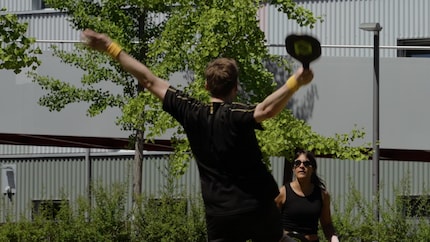
What’s the appeal?
As with spikeball, it only starts to get really dynamic when the players act in a tactically clever way, constantly repositioning themselves and reacting to the opposing team’s actions. In other words, when there’s movement and people rush each other around the court. This is only possible if everyone’s ambitious. That’s when something happens: you learn to anticipate situations and react accordingly. Unlike spikeball, in PaddleSmash the net stops the shot from being hit so flat it’s almost impossible to reach. That being said, if you hit the ball hard, it can go a long way in a high arc. The defending team therefore need to cover short and long distances. With well-coordinated teams, you can expect longer rallies and more fun.
How was PaddleSmash received?
I’m sure that when you see the game, you’ll know straight away if it’s something for you, your family and friends. I was immediately hooked – and Stefanie Lechthaler, Patrick Vogt and Luca Fontana had also caught PaddleSmash fever by the end of our session. If you’re looking for a kid-friendly activity, PaddleSmash is suitable from the age of eight if they have the feel for the game. It’ll then give you something that’ll continue to be challenging and pique their interest for years to come. When I was playing against my son, it only took about five minutes for him to get angry with me for the first time. That’s a good sign. Because there’s nothing more boring than a game that doesn’t get you riled up.
In a nutshell
Great game once you get the hang of it
PaddleSmash is a winning combination of spikeball and pickleball for a racket game you can set up in a small space. Rushing around the court on the beach, in the park or in your garden in this two-against-two game is fun. That is, once you’ve overcome the somewhat tough warm-up phase.
Still, it’s necessary to develop a feel for the ball and your position on the court. You look up a lot, but actually have to hit a relatively small area on the ground. Managing to do this on a regular basis is only possible when all players have reached a certain level. If you’ve got a good group playing, it’ll stay interesting for many summers to come.
You’ll pay considerably more for this than spikeball and about as much as for a classic pickleball set with a net. While it’s not cheap, it’s justifiable in view of the material quality.
Pro
- Good material quality
- Wooden bats
- Practical case that doubles as a court
- Doesn’t require much space
Contra
- Packing it away can be tricky
- No game flow at the beginning

Simple writer and dad of two who likes to be on the move, wading through everyday family life. Juggling several balls, I'll occasionally drop one. It could be a ball, or a remark. Or both.


